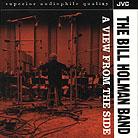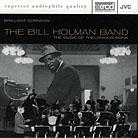| April 1999 ![[Reviewed on CD]](../format/regcd.gif) Jazz-band
arrangers have all but disappeared from the landscape of American popular music. The
declining popularity of jazz and the prohibitive expense of maintaining a big band has all
but eliminated the role of the arranger. Jazz has become the realm of the
soloist/superstar. It is, therefore, unusual to see a CD released by a big band, and still
more unusual to see a release of a big band featuring the work of a single arranger. Jazz-band
arrangers have all but disappeared from the landscape of American popular music. The
declining popularity of jazz and the prohibitive expense of maintaining a big band has all
but eliminated the role of the arranger. Jazz has become the realm of the
soloist/superstar. It is, therefore, unusual to see a CD released by a big band, and still
more unusual to see a release of a big band featuring the work of a single arranger.
Last year the JVC label released the second XRCD in as many years featuring the work of
The Bill Holman Band -- this one entitled Brilliant Corners: The Music of Thelonious
Monk. Previous to that was the XRCD entitled A View from the Side, featuring
Holman's original compositions and a couple of his arrangements of jazz standards. In a
way, these CDs celebrate the way things used to be: 16 highly trained musicians sitting
shoulder to shoulder and creating a sound that is rich and full with muscular block chords
at huge volumes that can knock you over.
For most of the 20th century, arrangers have been an indispensable part of the creative
process. If songwriters provided the fuel (the original songs), which was the raw material
that propagated the music industry, the arrangers provided the motor. Arrangers were the
artists who used their musical knowledge and talent to take whatever a writer gave them
and from it produce a finished musical composition. Not well known to the public, these
musicians were responsible for everything from creating the actual sound and style of the
popular big bands, to scoring the orchestra that accompanied The Beatles. Most recently,
due to composers' and producers' reliance on synthesizers for their productions, the need
for an arranger to create a score augmenting the core ensemble has almost disappeared.
Born in 1927, Bill Holman grew up during the golden era of the big bands. He was an
accomplished tenor saxophone player, but by 1950 he was distinguishing himself as an
arranger with bands led by Stan Kenton and Charlie Barnet.While the traditional post-World
War II big-band sound was homophonic, Holman strove to develop a style that was more
linear. Arrangements with contrapuntal inner voices became a trademark of his sound. This
style gave Holman the reputation of writing complex and edgy arrangements that were
outside the mainstream. It is this reputation that probably has led to his longevity in a
business that has been steadily dwindling since the '70s. For all his ability to write
standard arrangements, Holman's work never became stagnant.
Despite frequent metrical and tempo changes in the compositions that appear on this CD,
the emphasis in these recordings is on seamlessness and fluidity.There is a certain
smoothness in even the most turbulent compositions. The one exception to the rule is the
piece fashioned after Monk's "Brilliant Corners," where the band breaks into
hearty cacophony toward the end of the piece that is punctuated with a sharp unison at the
finish.
Holman's interpretation of Monk's "Friday The 13th" is one of the more
experimental arrangements recorded here, and the one that is most successful in blending
elements of serious 20th-century concert music and jazz. With a nod to Bartok, the piece
opens with a solo trumpet line reminiscent of Music for Strings Percussion and Celeste.
This theme is developed in the brass for a few measures, but when the whole band enters,
Holman retreats to safer confines of jazz scoring. Within those confines, he does his most
interesting contrapuntal work by lifting an inner voice that was accompanying the melody
and setting it starkly against the string bass. The effect is powerful and unusual.
Many of Holman's attempts to write in a more serious concert idiom for the jazz band have
a false ring to them. Often he adheres so closely to motifs of Monk's solos without
developing them that the repetitions become counter-productive. We learn that Holman
cannot or will not stray far from traditional jazz scoring. In harmonically challenging
sections, the band is instructed to play softly, and usually the percussion is absent.
This has the effect of an apology, and contrasts with the more traditional sections, which
are robust and fiery.
Holman’s original compositions stand in stark contrast to his arrangements on these
two CDs. A View from the Side contains seven original compositions that sound
tentative at best. It seems that Holman is not willing to take the risks in his own
compositions that he routinely invests in his arrangements of other composers' material.
Conversely, his arrangements of the two standards on this CD -- "But Beautiful"
and "The Tennessee Waltz" -- speak volumes about the role of an arranger in
jazz, and they are excellent examples for anyone in doubt about what arrangers do.
Despite some questionable experiments on these CDs, this is
an interesting body of work by one of the great craftsmen in his field. Holman will
continue to go out on a limb with his music, demanding your attention, and he will never
stop swinging.
GO BACK TO:
|
 The Bill Holman Band - A
View from the Side
The Bill Holman Band - A
View from the Side The Bill Holman Band - Brilliant Corners: The Music Of Thelonious Monk
The Bill Holman Band - Brilliant Corners: The Music Of Thelonious Monk![[Reviewed on CD]](../format/regcd.gif) Jazz-band
arrangers have all but disappeared from the landscape of American popular music. The
declining popularity of jazz and the prohibitive expense of maintaining a big band has all
but eliminated the role of the arranger. Jazz has become the realm of the
soloist/superstar. It is, therefore, unusual to see a CD released by a big band, and still
more unusual to see a release of a big band featuring the work of a single arranger.
Jazz-band
arrangers have all but disappeared from the landscape of American popular music. The
declining popularity of jazz and the prohibitive expense of maintaining a big band has all
but eliminated the role of the arranger. Jazz has become the realm of the
soloist/superstar. It is, therefore, unusual to see a CD released by a big band, and still
more unusual to see a release of a big band featuring the work of a single arranger.